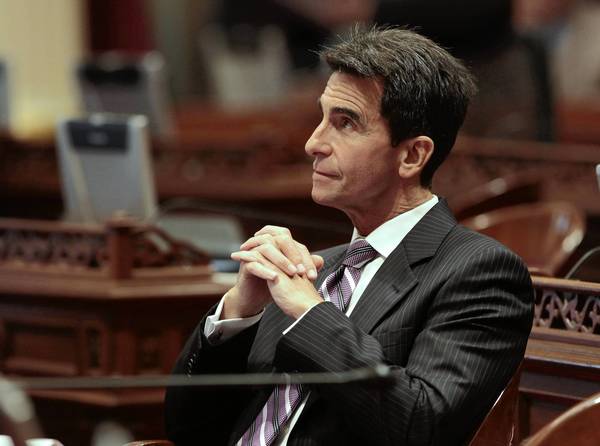WASHINGTON — California's elected Republicans have long had a simple approach to illegal immigration: Those who broke the law coming here should leave.
But the confluence of politics and personal threat have now put many Republican legislators in Washington and Sacramento in a very different place: eager to embrace an overhaul of immigration laws and willing to consider legal status for some of the country's nearly 12 million illegal immigrants, 3 million of whom live in California.
In Sacramento and Washington, party orthodoxy is being defied. At least six GOP legislators in Sacramento have aligned themselves with Democrats to support a path to citizenship for those in the country illegally. Several congressional Republicans from California have said they would consider granting legal status to some illegal immigrants as part of a comprehensive immigration overhaul.
The issue, which has tormented California Republicans for a generation, is unlikely to be far from members' minds this weekend as the state party holds its spring convention in Sacramento.
Rep. Ken Calvert (R-Corona), who once declared himself "wholeheartedly against amnesty," is among those now willing to consider granting legal status to some illegal immigrants, under specific conditions.
"I have a number of people who say, 'hell no,' " said Calvert, whose district is 36% Latino. "But I have a lot more people who understand that we're not going to do mass deportations."
A number of California Republicans remain vehemently opposed to granting legal status to illegal immigrants or won't consider it until convinced that the border is secure.
"You've got to secure the border, and you've got to prove it's secure. Period. We'll talk after that," said Rep. Duncan Hunter (R-Alpine).
"There is a path to citizenship," added Rep. Tom McClintock (R-Granite Bay.) "It's followed by millions of legal immigrants who have obeyed all of our laws."
The shift among others has been driven by recent election results and the expectation that Republicans' woeful trajectory in the state will not change without an alteration in the party's views.
In November, Republicans in Sacramento ceded a supermajority to Democrats in both houses of the California Legislature for the first time since 1883. At the same time, the number of Republicans in the state's 53-member House delegation dropped to 15, their lowest share since 1936, according to UC San Diego political scientist Gary Jacobson.
Barring a change, the future looks more bleak. The fastest-growing group of voters in the state are Latinos, whose voter registration has soared in the years since Republicans pushed 1994's Proposition 187, which would have banned government services to illegal immigrants. Latinos are expected to surpass whites to form a plurality of California's population by next year, according to state Department of Finance estimates, and Field Poll director Mark DiCamillo estimates that 23% of the state's registered voters are Latino. And they vote overwhelmingly for Democrats.
"The demographic changes are … irrefutable, and they require not just small message changes in the Republican Party but a tectonic shift," said Assemblyman Jeff Gorell (R-Camarillo), one of those who has broken with GOP orthodoxy. Gorell is among those who support a path to citizenship for illegal immigrants. He also supports granting them driver's licenses if they can document they have paid taxes in California, as proposed in legislation by Assemblyman Luis Alejo (D-Watsonville).
Already the state's demographic shifts have cast an ominous shadow over some Republicans. Mary Bono Mack, a veteran Republican member of Congress seen as having statewide potential, was ousted from her Palm Springs district last year by a Latino Democrat, Raul Ruiz. And four of the state's 15 GOP members of Congress represent districts where Latinos make up 40% or more of the population; five represent districts at least 30% Latino, according to the National Assn. of Latino Elected Officials Educational Fund.
"I'd not be truthful if I said that didn't have an impact," said Rep. John Campbell (R-Irvine).
Republicans also have come under pressure from interests in the Central Valley who back immigration measures that would allow a steady stream of farm workers. That area is home to many of the surviving Republican elected officials.
Nonetheless, some in the party dispute the notion that a change in policy is required. (The state party's platform asserts that "allowing illegal immigrants to remain in California undermines respect for the law.")
"I don't think pandering to a small group of people is going to help the Republican Party," said Celeste Greig, president of the California Republican Assembly, a grass-roots organization promoting conservative ideas within the party. "I don't think we should grant citizenship to people who blatantly came and broke the law."
California GOP Chairman Tom Del Beccaro also opposes measures that include a path to legalization. The country should secure the border before it considers what to do about residents who arrived illegally, Del Beccaro said.
Jim Brulte, the former Senate minority leader widely expected to be elected Sunday to replace Del Beccaro as chairman, has said the party needs to work harder to reach Latino voters. But Brulte declined to stake a position on the party's platform, saying his focus would be fundraising and rebuilding the organization's infrastructure.
richard.simon@latimes.com
patrick.mcgreevy@latimes.com
